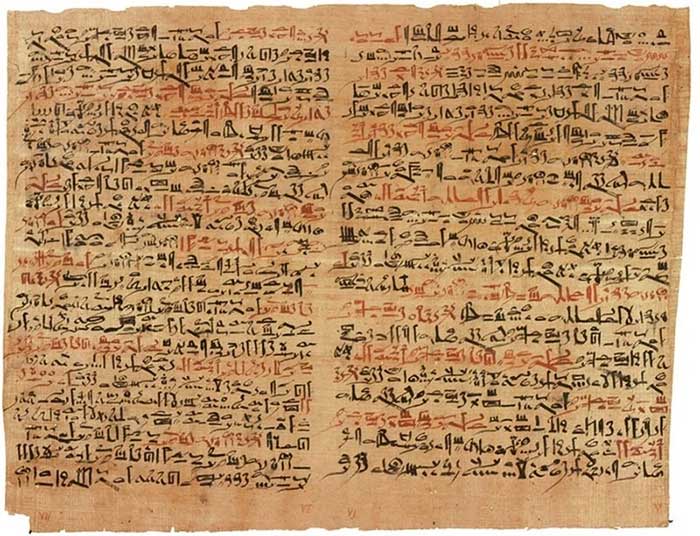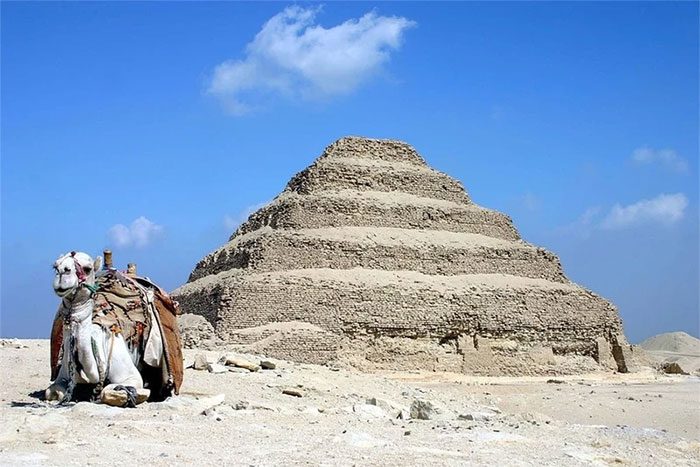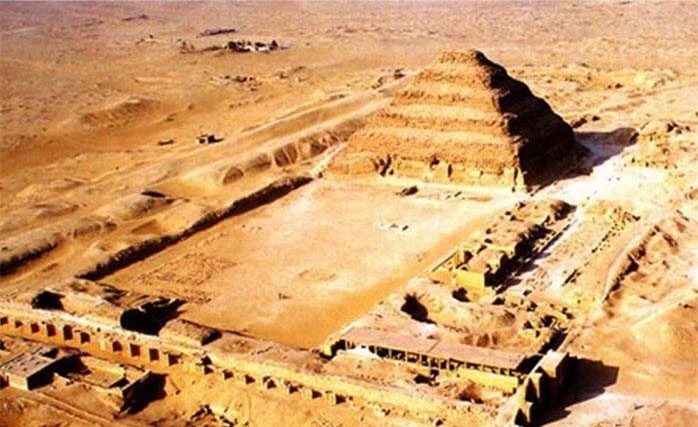However, many were astonished to learn about the achievements of this real historical figure for the “land of the pyramids.”
The first two parts of the film “The Mummy” were released in 1999 and 2001, making a significant impact. Among these, the character of Imhotep is an indispensable element contributing to that success.
After the film, Imhotep was remembered as a malevolent priest with boundless magical powers, leading an army of the undead. However, quite the opposite from the portrayal in the film, a man named Imhotep truly lived under the reign of the second king of the Third Dynasty—King Djoser.

Character Imhotep in the movie The Mummy.
Imhotep – a real Egyptian figure (2667-2600 BC) is known as a polymath of Egypt (a polymath is an expert in many fields). He was a chancellor, priest, architect, astronomer, sage, and even a medical researcher,…
He was also the only Egyptian aside from Amenhotep who was completely deified, becoming the god of wisdom and medicine due to his contributions over many reigns of Pharaohs.
Imhotep – The First Doctor in World History?
In ancient Egyptian history, under the rule of the Pharaohs, Imhotep is recognized as one of the most distinguished figures and a great scholar of Nile culture. Living around 2650 BC, Imhotep was known as a famous architect, astronomer, priest, and advisor to many Pharaohs, serving as chancellor under Pharaoh Zoser. However, few know that Imhotep was also the first doctor in ancient Egyptian and world history.
Imhotep was born in Ankhatowa—a village established very early on in the outskirts of Memphis, Egypt (some sources state that he came from the village of Gebelein, south of Thebes, Egypt). He was also known as Li-em-hotep, which in Egyptian means “the one who comes in peace.” His father was an architect named Kanofer, and his mother was a woman from Mendes named Khreduonkh. As he grew up, Imhotep married a woman named Ronfrenofert, and due to his intelligence, calculation skills, and talent, his career quickly flourished.
With numerous contributions to ancient Egypt, Imhotep authored the first book related to Egyptian medicine. In this book, he discussed the treatment of wounds, fractures, and even abscesses… He is regarded as the founder of Egyptian medicine.

The medical document named “Edwin Smith Paccorus,” believed to be compiled by Imhotep.
He was known as the author of many treatment methods for wounds and was the inventor of the first writing paper in Egypt—papyrus. On this paper, Imhotep recorded over 90 anatomical terms and described the treatment of more than 48 types of injuries and diseases.
At the height of his medical career, Imhotep established the first school dedicated to teaching wound treatment in Memphis, Egypt. His medical school, along with a culturally significant worship site of ancient Egyptian beliefs, lasted and thrived for thousands of years. Historical records indicate that all events related to Imhotep’s medical research occurred 2200 years before the father of Western medicine—Hippocrates was born.
In researching ancient Egyptian history and its notable figures, historian William Osler noted: “For the first time in history, humanity learned of a person who studied medicine over 2000 years ago.” During his medical practice, Imhotep diagnosed and treated approximately 200 types of diseases, including about 15 stomach and intestinal diseases, 11 bladder diseases, 10 rectal diseases, 29 eye diseases, 18 skin, hair, nail, and tongue conditions.
Notably, at that time, Imhotep researched and treated more complex illnesses beyond common injuries and infections, such as pulmonary tuberculosis, gallstones, appendicitis, gout, and arthritis. Professor Osler also discovered that despite the absence of formal medicine at that time, ancient Egyptians were well-versed in anatomy.
Indeed, the embalming process and preservation of mummified bodies in ancient Egypt demonstrated the anatomical knowledge of people from that era. One of the key contributors to the development of the embalming and anatomical process in ancient Egypt was none other than Imhotep. The powerful priest of Egypt was not only proficient in astronomy and architecture but also had a deep understanding of anatomy. Imhotep knew very well the locations of internal organs as well as the structure and functioning of the circulatory system.
He conducted many dissections on mummies and practiced dentistry. Ancient documents found in Egypt record that: “He was also knowledgeable in pharmacology and extracted medicines from various plants himself. Evidence of this is that the people of Egypt worshipped Imhotep as a god, and his temple became a center for teaching medicine to his followers and devotees.”
Imhotep – Architect of the Ancient Pyramids of Egypt
In addition to his fame in medical works, during the reign of King Djoser (around 2670 BC), with his innate talent, Imhotep became the Chancellor of the Pharaoh of Egypt, Chief of the Great Palace, Noble of the family line, High Priest of Heliopolis, Builder, Master Carpenter, Master Sculptor, and head of the pottery guild.
Imhotep was the architect of the Djoser Pyramid (also known as the Step Pyramid), one of the oldest stone structures in the world. The number of workers estimated to build these pyramids ranged from tens of thousands to hundreds of thousands.

Djoser Pyramid.
Later, the Great Pyramid of Giza became known as one of humanity’s greatest architectural achievements due to its unique and mysterious construction. However, few know that the Djoser Pyramid was the first pyramid, and it laid the crucial foundation for the design of subsequent pyramids. The responsibility for this design fell to none other than Chancellor Imhotep.
Before this era, burial structures were typically built in rectangular shapes with flat roofs and sloped sides made from mud brick or stone (commonly referred to as mastabas). However, when Imhotep took on the task, he decided to completely change the design to introduce distinctive improvements.
According to Wikipedia, The Djoser Pyramid was initiated from 2630 to 2611 BC. The complex spans 15 hectares and is 2.5 times larger than the city of Heirakonpolis, surrounded by a limestone wall about 10.5 meters high and over 1,600 meters long. The pyramid complex of Djoser has 13 false doors and only one actual entrance on the east.
The false doors are where the soul of the king could pass into the afterlife. The main entrance is quite narrow, flanked by stone columns supporting a limestone ceiling that rises over 6 meters high. Between each column is a small room, representing one province of Upper and Lower Egypt. The entrance leads to a wide courtyard. To the right of this courtyard, at the end of the main entrance, is Djoser’s pyramid. To the left of the courtyard is a burial chamber, known as the Southern Burial Chamber, believed to be the resting place of Djoser’s soul, constructed from granite.
Of course, achieving this was no small challenge for any architect, not just Imhotep. The issue at hand was how to balance the massive weight coming from the six mastabas while maintaining the structural integrity of the pyramid, preventing it from collapsing over time.
Upon completion, the Step Pyramid stood 204 feet (approximately 62 meters) tall and was the tallest structure of its time. The surrounding complex included a temple, inner courtyard, shrine, and living quarters for the priests, covering an area of up to 16 hectares and surrounded by a wall 30 feet (10.5 meters) high.
The most evident result of Imhotep’s success is the continued existence of the Step Pyramid to this day. Despite suffering numerous damages from both time and human activity, the Step Pyramid still stands tall after more than 4,600 years.

The Djoser Pyramid Complex (Step).
It is no coincidence that later generations recognize the greatness of Imhotep. Pharaoh Djoser was so impressed with Imhotep’s creativity that he disregarded the ancient precedent of having only the king’s name appear on monuments and allowed Imhotep’s name to be inscribed on the base of a statue. This is considered a unique honor for any Egyptian.
One hundred years after his death, Imhotep was elevated to the status of a god of medicine in Egypt. Approximately 2000 years after his passing, Imhotep replaced Nefertum in the triad of gods worshipped in Memphis, Egypt, and the name Imhotep became closely associated with the god Thoth—the deity of wisdom and knowledge, often represented by the Ibis.
Unlike the portrayal in films, Imhotep was a real historical figure who served under the Egyptian Pharaoh Djoser. His character and talents are entirely different from the cinematic depiction.
He is one of the very few individuals to have been immortalized in statues after his death. Imhotep died during the reign of Pharaoh Huni, the last dynasty of ancient Egypt. His burial place is located in Saqqara, Egypt, but to this day, no one knows the exact location of his tomb.


















































